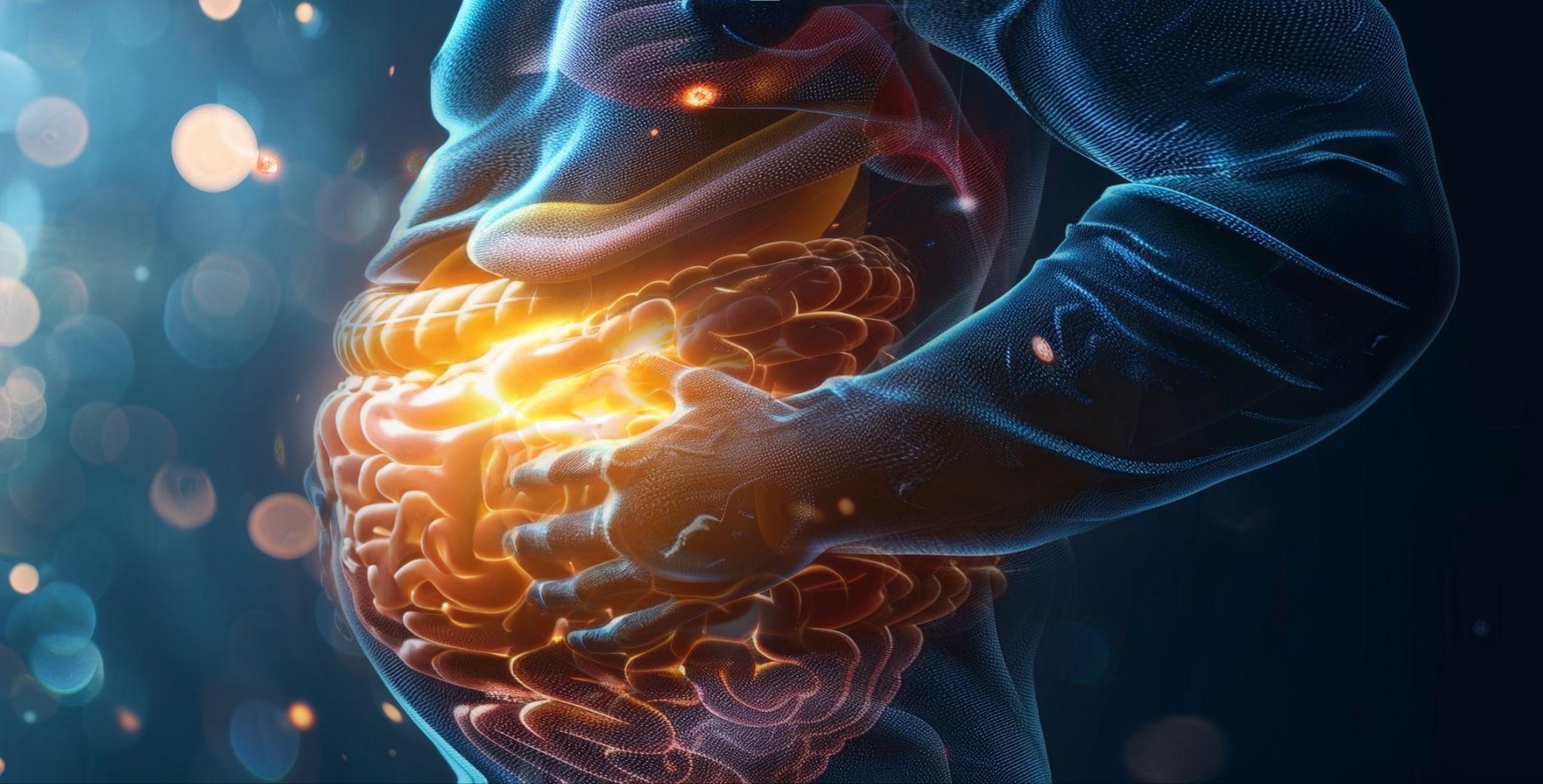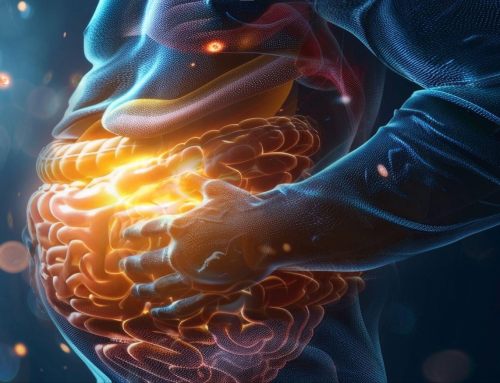Implications of the Vagus Nerve and Immune System Connection for Inflammation, Autoimmune Diseases & Mental Health
The vagus nerve is interconnected with nearly all the systems of the body and has a profound role in modulating immune function. It mediates vital processes crucial for the health of the body and mind. The functioning of the vagus nerve is significant in regulating homeostatic facets of health, and we can influence it.
Cues of Safety or Distress – Nociception
The body is always listening; the vagus nerve is a clear indicator of this. Its extensive distribution consists of two branches of nerve fibers. 80% are afferent, or sensory fibers that relay information about the state of the body’s physiology and inner organs up to the brain. The remaining 20% are composed of efferent, or motor fibers that send signals in the form of nerve impulses from the central nervous system (CNS) down to the body.
Nociception refers to how neural pathways of the autonomic system assess and become activated by sensory stimuli. This visceral nervous system is constantly evaluating information relative to our environment, and the physiological state of the body to determine if we are safe or in distress (1). These functions happen without conscious awareness (2).
Vagal Tone, A Modulator of Autonomic Function
The vagus nerve represents the main component of the parasympathetic nervous system (PNS), part of the autonomic nervous system (ANS), which oversees a vast array of automatic yet crucial homeostatic bodily functions. The vagus nerve influences the body’s stress response, the activity of the sympathetic nervous system (SNS), also part of the ANS. The enteric nervous system (ENS), or “second brain,” connects these systems to the GI tract, and all work in conjunction to facilitate bidirectional communication between the body and brain (CNS).
This wandering nerve, therefore, establishes connections between the brain and the gastrointestinal tract, relaying information relative to its physiological state via afferent and efferent fibers (3). It allows bidirectional modifications between the central nervous system and the ANS to modulate balance among hormonal, immune, and neurotransmitter functions (4).
Chronic external and internal forms of stress can compromise vagal tone and activate the ANS, making the body more susceptible to stress and being in a constant fight-or-flight response. When our body is chronically in this SNS mode, it offsets the balance of the ANS, resulting in a cascade of stress hormones and inflammatory cytokines to be released as the body adapts to the perceived stressor.
Crosstalk Between The Nervous System & The Immune System
The nervous and immune systems communicate with each other via intricate and vast coordinated mechanisms. They work in conjunction to provide homeostasis, as well as to mount responses of defense against pathogens, injury, or other threatening stimuli to the system. The vagus nerve is suggested to be involved in innate and adaptive arms of the immune system, as it exchanges communication amongst its organs — including the thymus, spleen, and lymph nodes.
This longest cranial nerve supports both innate immunity (our body’s initial response to the threat or the first line of defense), as well as adaptive immunity (a second layer of defense that is elicited if the innate immune system cannot clear the infection or invader). Adaptive immunity functions by recognition of antigen-specific immunity with the help of B and T memory cells, allowing for recall of these invaders or threats to the body. The immune system creates an immunological memory–or imprint–and antibodies to prepare and protect it from future threats (5, 6).
Immunomodulatory Functions
The vagus nerve is a physiological modulator of immune function and inflammation.
The bidirectional communication that occurs between the vagus nerve and the immune system is mediated by efferent vagus nerve cholinergic output to the spleen, liver, and GI tract. This supports modulation of immune activation while suppressing proinflammatory cytokine release. While inflammation is an essential component of the innate immune system, excessive or chronic production results in a generalized systemic inflammatory response, which can compromise immunity and other systems of the body.
Immune cells such as macrophages, neutrophils, monocytes, and T lymphocytes detect the presence of pathogen invaders or injury and release cytokines and other signaling molecules. Alterations in immune system balance are detected by the vagus nerve, which relays this information to the brain and spinal cord.
Inflammatory Reflex Pathway & Mechanisms
Dysregulation of immune function is associated with chronic inflammation. Activation of the efferent arm of the inflammatory reflex describes neural circuitry of the vagus nerve that modulates immune responses. These cholinergic mechanisms within the inflammatory reflex are known for their role in down-regulating inflammation and the stress response (5). The vagus nerve, via this inflammatory mechanism, controls innate immune responses and inflammation, helping to counteract adrenaline, cortisol, and other stress hormones.
Efferent signals transmitted by the vagus nerve via this acetylcholine pathway modulate and reduce systemic inflammation. Inhibition of inflammatory cytokines, such as the NF-κB signaling pathway, and activation of macrophages and other immune cells are implicated (5).
Neuroimmune Communication
The vagus nerve has a significant role in modulating immunity, as it senses visceral information in the body and relays this up to the brain. Neural input also influences regulation of immunity, in addition to immune regulatory output (7).
Sensory nerve fibers originate from the dorsal root ganglia (DRG) of the vagus nerve and travel via the spinal cord, relaying messages to the CNS. Afferent fibers also send information to the nucleus tractus solitarii (NTS), with projections to further brain regions within the dorsal vagal complex, brainstem, and multiple hypothalamic areas (5, 7). Communication between the vagus nerve with other neural circuitry is significant in influencing inflammation (8). Multiple brain regions (raphe nucleus, locus coeruleus, thalamus, hypothalamus, amygdala, and cerebral cortex) have been found to be implicated during vagal activation (9), further illustrating its wide-reaching impact.
Neuronal processes are altered by conditions associated with immune dysregulation and inflammation. Similarly, immunity can be impacted by an overdrive in brain circuits due to chronic stress. When we are stressed, certain brain circuits are involved, which increases our susceptibility to illness (10). Stimulation of the vagus nerve helps to counteract stress. The inflammatory reflex of the vagus nerve serves as a physiological regulator in the body. It supports the modulation of immunity, inflammation, and mood by releasing acetylcholine and catecholamines that interact with immune cells (7).
Immune Dysregulation & Inflammation
Dysregulation of metabolic and immune function is associated with chronic systemic inflammation. Inflammation damages cells and tissues in the body and can contribute to compromised mental health, as well as immune dysregulation and autoimmune complications (5).
When the body is under chronic stress or in a state of threat, it can result in inflammation, wreaking havoc on these systems. Inflammatory mediators, or cytokines, are released by immune cells in response, activating sensory neurons (7). Psychoneuroimmunology (PNI) describes the bidirectional relationship between the nervous, immune, and endocrine systems. PNI highlights the science behind the complex interplay of chronic stress, neuroinflammation, compromised immunity, and the manifestation of mental health symptoms.
The Role of Stress in Neuroinflammation, Immunity & Mental Health
Emerging research reveals a connection between reduced immune function, inflammation, and depression. This further highlights the profound role of stress. The immune system becomes compromised from chronic stress, and alterations in T-helper cells result, leading to an increased inflammatory state. Biomarkers of inflammation, such as IL-6 and tumor necrosis factor, have also been found to be elevated in those with compromised immune function and depression (12).
The tryptophan-kynurenine pathway is implicated in inflammation, immune health, depression, and possibly other psychiatric conditions. This pathway is suggested to be altered in those struggling with mental health and dysregulated immune function. Chronic stress and associated immune modifications can impact this system by inducing activation of cortisol and cytokines (13). This can further wreak havoc on a number of subsequent body systems as a result (14).
Stimulation of the vagus nerve supports modulation of neurotransmitter concentrations significant for mood, such as norepinephrine and serotonin. Neuromodulation, therefore, may be an efficacious treatment for various inflammatory disorders – such as immune, autoimmune, and mental health disorders.
When the Body is Inflamed, So is the Brain
If the immune system is chronically under attack from stress, and an inflammatory and insufficient diet and lifestyle, it is more prone to attack its own tissues. This is because it can throw the body’s microbiome ecosystem off, causing it to be more toxic. Nearly 80% of the immune system is housed in the gut, which further underscores this concept. When the gut is out of balance therefore, it can significantly compromise immunity and mood. It has been estimated that at least 30 neurotransmitters are synthesized in the gut.
The way food becomes digested and absorbed can also be compromised due to chronic stress and impaired vagal tone. Intestinal permeability or leaky gut can occur, which can result in complex chronic illness, leading us to experience our own body as a threat. This can further compromise vagal tone, contribute to inflammation, and impede mental and immune health.
Understanding the mechanisms related to the vagal tone and how it supports countless facets of health can support more efficacious treatment protocols, such as nutrition and lifestyle, as well as neuromodulation practices for inflammatory, autoimmune disorders as well as mental health (15).
Utilizing the vagus nerve as a targeted approach to these health concerns can also support rebuilding signals of safety in the body. What is encouraging is that neuroplasticity allows us to rewire our nervous system to a large extent.
It is also important to recognize that early stressors, such as adverse childhood experiences (ACEs) and trauma, have an impact on the early wiring of our nervous system. The vagus nerve supports our ability to self-regulate and repeatedly gives our body and brain what it needs to feel safe and be in good health.
Physical stressors have a large impact as well. Autoimmune conditions may occur when the adaptive immune system mistakes food antigens, such as gluten, as foreign from the body, inducing an inflammatory autoimmune response. Molecular mimicry describes the immune system forming this response. Gluten, for instance, triggers the release of zonulin, a chemical that signals tight junctions in the gut to open, which can result in intestinal permeability (16). Casein from dairy may also elicit a similar response, disrupting the gut, which can further contribute to inflammation and toxic build-up in the system.
The Healing Properties of the Vagus Nerve
Polyvagal Theory highlights that our nervous system evolved to shift between circuits of functioning due to the influences exerted on the ANS by the CNS and sensory information. This theory states that there are three neural circuits of the vagus nerve that developed based on hierarchical needs of safety. The ventral circuit was recently discovered and has been implicated when we feel safe enough to engage socially and play (11). The sympathetic system, or second subset of circuitry, is associated with the fight or flight response, whereas the dorsal vagal system is a final set of circuitry that exists relating to defense, immobilization, and the shutting down mode in the face of threat. This system has been implicated to be involved in dissociation from trauma.
So, it makes sense that the vagus nerve has been suggested to have a role in mental health conditions such as depression and anxiety, via inflammatory modulation, as well as alterations in the microbiota-gut brain axis. As the vagus nerve facilitates communication between the central nervous system (brain) and the body, through its afferent and efferent branches, it is significant for modulating mental health conditions. Vagus fibers can sense and relay information from the gut to the brain, as well as vice versa, from the central nervous system to the gut. Chronic stress can lead to intestinal permeability, gut microbiome changes, and inflammation. This is important as hormones and neurotransmitters are synthesized in the gut that have a role in mental health.
Improving vagal tone can mitigate stress and improve mood. Depression has also been associated with low vagal tone. The vagus nerve, therefore, may be a promising targeted intervention for depression and other mental health conditions (17).
Dysbiosis has also been shown to be prevalent in those with depression and anxiety. This imbalance in gut bacteria also has an impact on neurotransmitter production and compromises neuronal circuitry, neurogenesis, and neuroplasticity, and can result in neuroinflammation (18, 19).
Vagal afferent fibers transmit signals from the gut microbiota to the central nervous system. Signals include serotonin, cholecystokinin, glucagon-like peptide-1, peptide YY, enteroendocrine cells, short-chain fatty acids, microbe-associated molecular patterns, and lipopolysaccharides – all of which have an impact on modulating inflammation, immunity and mental health (20).
Vagal Nerve Stimulation for Stress-Related Conditions
Vagal Nerve Stimulation (VNS) has been suggested to be efficacious in the treatment of stress-related depression and mental health conditions. VNS devices have been developed, allowing for external stimulation of the vagus nerve. Improved physiological and psychological symptoms have been demonstrated in patients with stress-related psychiatric disorders. VNS has been found to exert beneficial effects on autonomic nervous system tone, reduce inflammation, and improve brain areas involved in emotional regulation. These improved effects were evidenced by brain imaging and blood biomarkers of inflammation (21). These devices, therefore, may be particularly beneficial for those with stress-related mental health and autoimmune conditions.
Mindfulness & Balance
The bidirectional communication between the vagus nerve and the immune system further underscores the importance of the mind-body connection. The body is indeed always listening. So, increasing our awareness of this interrelationship, tuning in, and taking care of ourselves – body and mind – is vitally important to optimal health.
Our nervous system wiring is not our destiny; we can exert control and modulate it by improving vagal tone by implementing nutrition and lifestyle practices. Following a balanced, nutrient-dense, anti-inflammatory diet that supports immunity and gut health can support vagal tone. Ensuring quality and restorative sleep is also important in improving vagal function. These processes support feelings of safety in the physiology of the body.
Meditation, yoga, breathwork, and social connections are also significant, as we can find co-regulation with others (22). Our breath is also powerful, as it can support improved HRV, an indicator of vagal tone (23). Extended sighs or exhales have been implicated in influencing PNS dominance mode, supporting balance in the system. Exercise has also been shown to reduce inflammation and stress via the vagus nerve— which can contribute to better health outcomes for immunity and mental health (24).
Forest bathing (spending time in nature while mindfully engaging the senses with the natural environment) can also further support the modulation of stress, immunity, and inflammation. Cold plunges, laughing, and gargling are further ways of activating the vagus nerve, in addition to exploring vagus nerve stimulation devices. Finally, activation of deep fascia through massage or acupuncture has been suggested to stimulate the vagal adrenal axis, supporting markers of stress, inflammation, and immunity (24).
Our nervous system is malleable. We can reinforce positive neural pathways conducive to improving all facets of our health by supporting this powerful bundle of nerves.
Improving Vagal Tone & Immunity
You won’t want to miss this thought-provoking and insightful conversation relative to the vagus nerve and its relevance in modulating mind-body balance – and the resulting vast implications for all aspects of health. This event will take place on February 27th from 5-7 pm. Participants will hear from leading experts in the field Peter Staats, Navaz Habib, and Jeffrey Bland.
References:
- Fang YT, Lin YT, Tseng WL, Tseng P, Hua GL, Chao YJ, Wu YJ. Neuroimmunomodulation of vagus nerve stimulation and the therapeutic implications. Front Aging Neurosci. 2023 Jul 6;15:1173987. doi: 10.3389/fnagi.2023.1173987. PMID: 37484689; PMCID: PMC10358778.
- McCorry LK. Physiology of the autonomic nervous system. Am J Pharm Educ. 2007 Aug 15;71(4):78. doi: 10.5688/aj710478. PMID: 17786266; PMCID: PMC1959222.
- Breit S, Kupferberg A, Rogler G, Hasler G. Vagus Nerve as Modulator of the Brain-Gut Axis in Psychiatric and Inflammatory Disorders. Front Psychiatry. 2018 Mar 13;9:44. doi: 10.3389/fpsyt.2018.00044. PMID: 29593576; PMCID: PMC5859128.
- Carabotti M., Scirocco A., Maselli M. A., Severi C. (2015). The gut-brain axis: interactions between enteric microbiota, central and enteric nervous systems. Gastroenterol. 28, 203–209. [PMC free article] [PubMed] [Google Scholar
- Pavlov VA, Tracey KJ. The vagus nerve and the inflammatory reflex–linking immunity and metabolism. Nat Rev Endocrinol. 2012 Dec;8(12):743-54. doi: 10.1038/nrendo.2012.189. PMID: 23169440; PMCID: PMC4082307.
- Weyand CM, Goronzy JJ. Aging of the Immune System. Mechanisms and Therapeutic Targets. Ann Am Thorac Soc. 2016 Dec;13 Suppl 5(Suppl 5):S422-S428. doi: 10.1513/AnnalsATS.201602-095AW. PMID: 28005419; PMCID: PMC5291468.
- Pavlov VA, Chavan, SS & Tracey K. J. (2018). Molecular and Functional Neuroscience in Immunity. Annual Review of Immunology, 36: 1, 783- 812.
- Falvey A, Metz CN, Tracey KJ, Pavlov VA. Peripheral nerve stimulation and immunity: the expanding opportunities for providing mechanistic insight and therapeutic intervention. Int Immunol. 2022 Jan 22;34(2):107-118. doi: 10.1093/intimm/dxab068. PMID: 34498051; PMCID: PMC8783605.
- Decarie-Spain L., Hayes A. M. R., Lauer L. T., Kanoski S. E. (2023). The gut-brain axis and cognitive control: a role for the vagus nerve. Cell Dev. Biol. 3, S1084-9521(23)00032–0. 10.1016/j.semcdb.2023.02.004 [PMC free article][PubMed] [CrossRef] [Google Scholar]
- Bains, J.S., Sharkey, K.A. Stress and immunity — the circuit makes the difference. Nat Immunol 23, 1137–1139 (2022). https://doi.org/10.1038/s41590-022-01276-1
- Porges SW. The polyvagal theory: new insights into adaptive reactions of the autonomic nervous system. Cleve Clin J Med. 2009 Apr;76 Suppl 2(Suppl 2):S86-90. doi: 10.3949/ccjm.76.s2.17. PMID: 19376991; PMCID: PMC3108032.
- Herman JP, McKlveen JM, Ghosal S, Kopp B, Wulsin A, Makinson R, Scheimann J, Myers B. Regulation of the Hypothalamic-Pituitary-Adrenocortical Stress Response. Compr Physiol. 2016 Mar 15;6(2):603-21. doi: 10.1002/cphy.c150015. PMID: 27065163; PMCID: PMC4867107.
- Giunta S, Xia S, Pelliccioni G, Olivieri F. Autonomic nervous system imbalance during aging contributes to impair endogenous anti-inflammaging strategies. 2023 Oct 11. doi: 10.1007/s11357-023-00947-7. Epub ahead of print. PMID: 37821752.
- Mayer, E. A., Savidge, T., and Shulman, R. J. (2014). Brain-gut microbiome interactions and functional bowel disorders. Gastroenterology 146, 1500–1512. doi: 10.1053/j.gastro.2014.02.037
- 6- Herman JP, McKlveen JM, Ghosal S, Kopp B, Wulsin A, Makinson R, Scheimann J, Myers B. Regulation of the Hypothalamic-Pituitary-Adrenocortical Stress Response. Compr Physiol. 2016 Mar 15;6(2):603-21. doi: 10.1002/cphy.c150015. PMID: 27065163; PMCID: PMC4867107.
- Manza F, Lungaro L, Costanzini A, Caputo F, Volta U, De Giorgio R, Caio G. Gluten and Wheat in Women’s Health: Beyond the Gut. Nutrients. 2024; 16(2):322. https://doi.org/10.3390/nu16020322
- Tan C, Yan Q, Ma Y, Fang J, Yang Y. Recognizing the role of the vagus nerve in depression from microbiota-gut brain axis. Front Neurol. 2022 Nov 10;13:1015175. doi: 10.3389/fneur.2022.1015175. PMID: 36438957; PMCID: PMC9685564.
- Troubat R, Barone P, Leman S, Desmidt T, Cressant A, Atanasova B, et al.. Neuroinflammation and depression: a review. Eur J Neurosci. (2021) 53:151–71. 10.1111/ejn.14720 [PubMed] [CrossRef] [Google Scholar]
- Tartt AN, Mariani MB, Hen R, Mann JJ, Boldrini M. Dysregulation of adult hippocampal neuroplasticity in major depression: pathogenesis and therapeutic implications. Mol Psychiatr. (2022) 27:2689–99. 10.1038/s41380-022-01520-y [PMC free article] [PubMed] [CrossRef] [Google Scholar]
- Han Y, Wang B, Gao H, He C, Hua R, Liang C, Zhang S, Wang Y, Xin S, Xu J. Vagus Nerve and Underlying Impact on the Gut Microbiota-Brain Axis in Behavior and Neurodegenerative Diseases. J Inflamm Res. 2022 Nov 9;15:6213-6230. doi: 10.2147/JIR.S384949. PMID: 36386584; PMCID: PMC9656367.
- Bremner JD, Gurel NZ, Wittbrodt MT, Shandhi MH, Rapaport MH, Nye JA, Pearce BD, Vaccarino V, Shah AJ, Park J, Bikson M, Inan OT. Application of Noninvasive Vagal Nerve Stimulation to Stress-Related Psychiatric Disorders. J Pers Med. 2020 Sep 9;10(3):119. doi: 10.3390/jpm10030119. PMID: 32916852; PMCID: PMC7563188.
- C. Streeter, P.L. Gerbarg, R.B. Saper, D.A. Ciraulo, R.P. Brown. Effects of yoga on the autonomic nervous system, gamma-aminobutyric-acid, and allostasis in epilepsy, depression, and post-traumatic stress disorder. Medical Hypotheses,Volume 78, Issue 5,2012,
- Magnon V, Dutheil F, Vallet GT. Benefits from one session of deep and slow breathing on vagal tone and anxiety in young and older adults. Sci Rep. 2021 Sep 29;11(1):19267. doi: 10.1038/s41598-021-98736-9. PMID: 34588511; PMCID: PMC8481564.
- Mikkelsen K, Stojanovska L, Polenakovic M, Bosevski M, Apostolopoulos V. Exercise and mental health. Maturitas. 2017 Dec;106:48-56. doi: 10.1016/j.maturitas.2017.09.003. Epub 2017 Sep 7. PMID: 29150166.
- Pham T, Lau ZJ, Chen SHA, Makowski D. Heart Rate Variability in Psychology: A Review of HRV Indices and an Analysis Tutorial. Sensors (Basel). 2021 Jun 9;21(12):3998. doi: 10.3390/s21123998. PMID: 34207927; PMCID: PMC8230044












